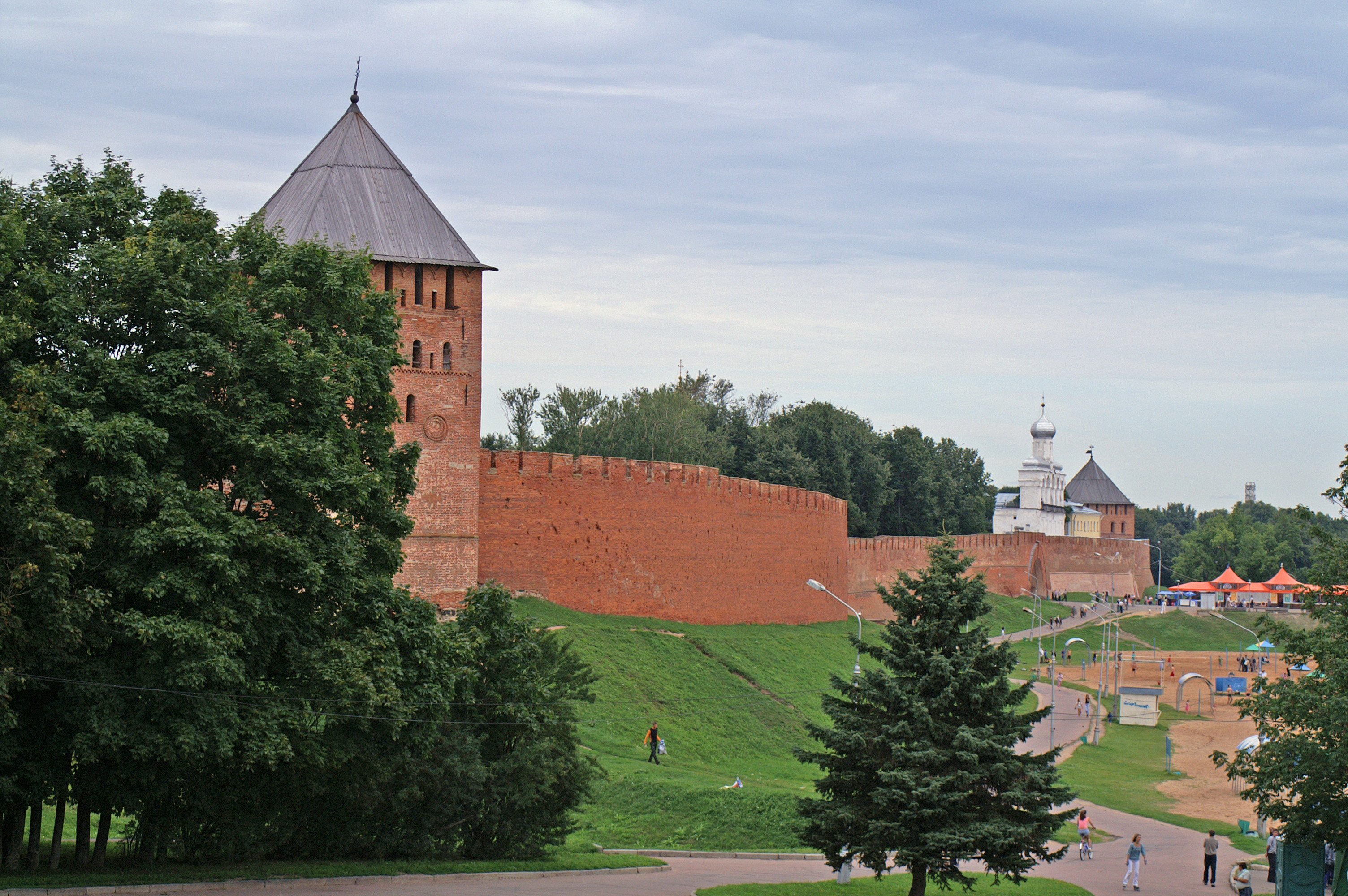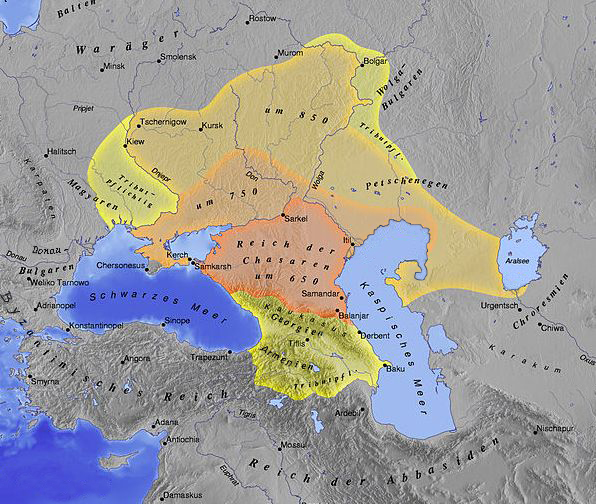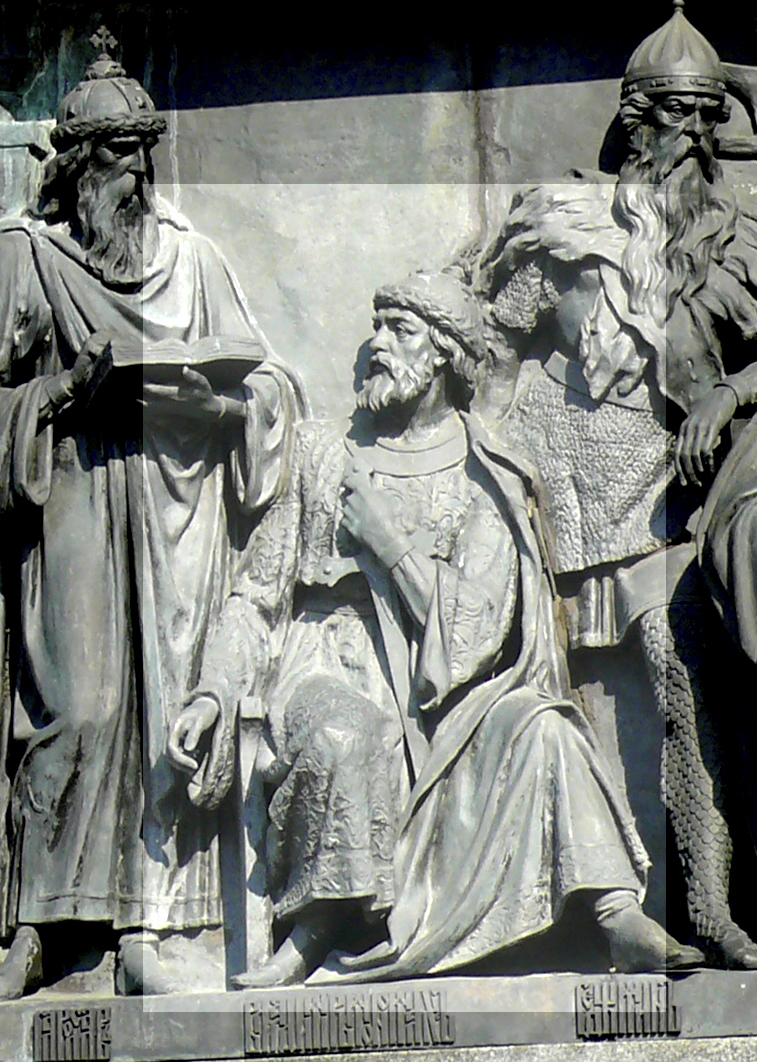|
Vladimir Of Novgorod
Vladimir Yaroslavich (russian: Владимир Ярославич, Old Norse ''Valdamarr Jarizleifsson''; 1020 – October 4, 1052) reigned as prince of Novgorod from 1036 until his death. He was the eldest son of Yaroslav I the Wise of Kiev by Ingigerd, daughter of king Olof Skötkonung of Sweden. In the state affairs he was assisted by the voivode Vyshata and the bishop Luka Zhidiata. In 1042, Vladimir may have been in conflict with Finns, according to some interpretations even making a military campaign in Finland. In the next year he led the Russian armies against the Byzantine emperor Constantine IX. He predeceased his father by two years and was buried by him in St Sophia Cathedral he had built in Novgorod. His sarcophagus is in a niche on the south side of the main body of the cathedral overlooking the Martirievskii Porch. He is depicted in an early twentieth-century fresco above the sarcophagus and on a new effigial icon on top of the sarcophagus. The details of his d ... [...More Info...] [...Related Items...] OR: [Wikipedia] [Google] [Baidu] |
Novgorod Land
Novgorodian Land (russian: Новгородская земля) was one of the largest historical territorial–state formations in Russia, covering its Northwest Russia, northwest and Russian North, north. Novgorod Land, centered in Veliky Novgorod, was the cradle of Kievan Rus', Old Russian statehood under the rule of the Rurik dynasty, Rurikovich dynasty and one of the most important princely thrones of the era of Kievan Rus'. During the collapse of Kievan Rus' and in subsequent centuries, Novgorod Land developed as Novgorod Republic, an autonomous Russian state with republican forms of government under the suzerainty of the Vladimir-Suzdal, great princes of Vladimir (later – Grand Duchy of Moscow, Moscow).Anton Gorsky. Russian Lands in the 13th–14th Centuries: the Path of Political Development – Saint Petersburg: Nauka, 2016 – Pages 63–67Alexander Filyushkin. Titles of Russian Sovereigns – Moscow; Saint Petersburg: Alliance Archeo, 2006 – Pages 39–40 During the ... [...More Info...] [...Related Items...] OR: [Wikipedia] [Google] [Baidu] |
Archbishop Of Novgorod
The Diocese of Novgorod (russian: Новгородская епархия) is one of the oldest offices in the Russian Orthodox Church. The medieval archbishops of Novgorod were among the most important figures in medieval Russian history and culture and their successors (as bishops, archbishops, or metropolitans) have continued to play significant roles in Russian history up to the present day. They patronized a significant number of churches in and around the city, (several of which can still be seen today), and their artistic and architectural embellishments influenced later Russian art and architecture; they also patronized chronicle-writing, a crucial source on medieval Russian history. The Republican period The office of bishop of Novgorod was created around the time of the Christianization of Rus' (988), although the chronicles give conflicting dates for its establishment ranging anywhere from 989 to 992. The first bishop, Ioakim Korsunianin (ca. 989-1030), built the ... [...More Info...] [...Related Items...] OR: [Wikipedia] [Google] [Baidu] |
Vladimir Monomakh
Vladimir II Monomakh (Old East Slavic: Володимѣръ Мономахъ, ''Volodiměrŭ Monomakhŭ''; uk, Володимир Мономах, translit=Volodymyr Monomakh; russian: Владимир Мономах; Christian name: ''Vasiliy'', ''Vasyl'', or '' Basileios'') (26 May 1053 – 19 May 1125) reigned as Grand Prince of the Medieval Rus' from 1113 to 1125. He is considered a saint in the Eastern Orthodox Church and is celebrated on May 6. Family He was the son of Vsevolod I (married in 1046) and a relative of Byzantine emperor Constantine IX Monomachos, from whom Vladimir obtained his sobriquet. Contemporary Byzantine naming practice allowed the adoption of a maternal surname if the mother's family was perceived to be of a more exalted origin than that of the father. Reign In his famous ''Instruction'' (also known as ''The Testament'') to his own children, Monomakh mentions that he conducted 83 military campaigns and 19 times made peace with the Polovtsi. At ... [...More Info...] [...Related Items...] OR: [Wikipedia] [Google] [Baidu] |
Vladimir The Great
Vladimir I Sviatoslavich or Volodymyr I Sviatoslavych ( orv, Володимѣръ Свѧтославичь, ''Volodiměrъ Svętoslavičь'';, ''Uladzimir'', russian: Владимир, ''Vladimir'', uk, Володимир, ''Volodymyr''. See Vladimir (name) for details., ''Vladimir Svyatoslavich''; uk, Володимир Святославич, ''Volodymyr Sviatoslavych''; Old Norse ''Valdamarr gamli''; c. 95815 July 1015), also known as Vladimir the Great or Volodymyr the Great, was Prince of Novgorod, Grand Prince of Kiev, and ruler of Kievan Rus' from 980 to 1015. Vladimir's father was Prince Sviatoslav I of Kiev of the Rurikid dynasty. After the death of his father in 972, Vladimir, who was then prince of Novgorod, was forced to flee to Scandinavia in 976 after his brother Yaropolk murdered his other brother Oleg of Drelinia, becoming the sole ruler of Rus'. In Sweden, with the help of his relative Ladejarl Håkon Sigurdsson, ruler of Norway, he assembled a Varangian ... [...More Info...] [...Related Items...] OR: [Wikipedia] [Google] [Baidu] |
Halychyna
Galicia ()"Galicia" '''' ( uk, Галичина, translit=Halychyna ; pl, Galicja; yi, גאַליציע) is a historical and geographic region spanning what is now southeastern and western , long part of the . ... [...More Info...] [...Related Items...] OR: [Wikipedia] [Google] [Baidu] |
Izgoi
Izgoi is a term that is found in medieval Kievan Rus'. In primary documents, it indicated orphans who were protected by the church. In historiographic writing on the period, the term was meant as a prince in Kievan Rus' who was excluded from succession to the Kievan throne because his father had not held the throne before. In Kievan Rus', as well as Appanage and early Muscovite Russia, collateral succession, rather than linear succession, was practiced, with the throne being passed from the eldest brother to the youngest brother and then to cousins until the fourth in line of succession (not to be confused with "fourth cousins") in a generation before it was passed on to the eldest member of the senior line if his father had held the Kievan throne. The princes were placed in a hierarchy or "ladder" or "staircase" of principalities, which Sergei Soloviev called the " Rota System" (rota being the Old Church Slavic term for a ladder or staircase), with Kiev as the pinnacle. When the ... [...More Info...] [...Related Items...] OR: [Wikipedia] [Google] [Baidu] |
Tmutarakan
Tmutarakan ( rus, Тмутарака́нь, p=tmʊtərɐˈkanʲ, ; uk, Тмуторокань, Tmutorokan) was a medieval Kievan Rus' principality and trading town that controlled the Cimmerian Bosporus, the passage from the Black Sea to the Sea of Azov, between the late 10th and 11th centuries. Its site was the ancient Greek colony of Hermonassa ( grc, Ἑρμώνασσα) founded in the mid 6th century BCE, by Mytilene (Lesbos), situated on the Taman peninsula, in the present-day Krasnodar Krai of Russia, roughly opposite Kerch. The Khazar fortress of Tamantarkhan (from which the Byzantine name for the city, Tamatarcha, is derived) was built on the site in the 7th century, and became known as Tmutarakan when it came under Kievan Rus control. History The Greek colony of Hermonassa was located a few miles west of Phanagoria and Panticapaeum, major trade centers for what was to become the Bosporan Kingdom. The city was founded in the mid-6th century BCE by Mytilene (Lesbos), al ... [...More Info...] [...Related Items...] OR: [Wikipedia] [Google] [Baidu] |
Vsevolod I, Prince Of Kiev
Vsevolod I Yaroslavich (Russian language, Russian: Всеволод I Ярославич, Ukrainian language, Ukrainian: Всеволод I Ярославич, Old Norse: Vissivald) (c. 1030 – 13 April 1093), ruled as Grand Prince of Kiev from 1078 until his death. Early life He was the fifth and favourite son of Yaroslav I the Wise by Ingegerd Olofsdotter, Ingigerd Olafsdottir. He was born around 1030. On his seal from his last years, he was named "Andrei Vsevolodu" in Greek, implying that his baptismal name was Andrew. To back up Rus'-Byzantine War (1043), an armistice signed with the Byzantine Empire, Byzantine Emperor Constantine IX Monomachos in 1046, his father married Vsevolod to a Byzantine princess, who according to tradition was named Anastasia or Maria. That the couple's son Vladimir II Monomakh, Vladimir Monomakh bore the family name of the Byzantine emperor suggests she was a member of his close family, but no contemporary evidence attests to a specific rela ... [...More Info...] [...Related Items...] OR: [Wikipedia] [Google] [Baidu] |
Svyatoslav II
Sviatoslav II Iaroslavich or Sviatoslav II Yaroslavich ( orv, Ст҃ославь Ӕрославичь; Russian and Ukrainian: Святослав Ярославич; 1027 – 27 December 1076) was Grand Prince of Kiev between 1073 and 1076. He was born as a younger son of Grand Prince Yaroslav the Wise. His baptismal name was Nicholas. He ruled the Principality of Vladimir in Volhynia in his father's lifetime (from around 1040 to 1054). Yaroslav the Wise, who divided the Kievan Rus' among his five sons in his testament, willed the Principality of Chernigov to Sviatoslav. Sviatoslav joined his brothers, Iziaslav of Kiev and Vsevolod of Pereyaslav, in forming a princely "triumvirate" that oversaw the affairs of Kievan Rus' until 1072. The three brothers together fought against their enemies, including the nomadic Oghuz Turks, and their distant relative, Prince Vseslav of Polotsk. The Cumans defeated their united force in the autumn of 1068, but Sviatoslav routed a Cuman ban ... [...More Info...] [...Related Items...] OR: [Wikipedia] [Google] [Baidu] |
Izyaslav I
Iziaslav Yaroslavich ( orv, Изѧславь Ѩрославичь; russian: Изяслав Ярославич; uk, Ізяслав Ярославич; 1024 – 3 October 1078, baptized as ''Demetrius'') was a Kniaz' ( Prince) of Turov and Grand Prince of Kiev from 1054. Iziaslav's children Yaropolk and Sviatopolk would rule the Turov Principality. Their authority was mainly challenged by the Rostilavichi of Rostislav Vsevolodovich. Biography Iziaslav was the oldest son of Yaroslav I the Wise by his second wife Ingigerd Olafsdottir. Iziaslav succeeded his father, after Yaroslav's oldest child, Vladimir (the only child by Yaroslav's first wife), had predeceased his father. Iziaslav was one of the authors of ''"Pravda Yaroslavichiv"'' – a part of the first legal code of Rus, called Russkaya Pravda. He is also credited with the foundation of the Kiev Pechersk Monastery. Prince Iziaslav I of Kiev ceded the whole mountain to Antonite monks who founded a monastery built by archit ... [...More Info...] [...Related Items...] OR: [Wikipedia] [Google] [Baidu] |
Constantine IX
Constantine IX Monomachos ( grc-x-medieval, Κωνσταντῖνος Μονομάχος, translit=Kōnstantinos IX Monomachos; 1004 – 11 January 1055), reigned as Byzantine emperor from June 1042 to January 1055. Empress Zoë Porphyrogenita chose him as a husband and co-emperor in 1042, although he had been exiled for conspiring against her previous husband, Emperor Michael IV the Paphlagonian. The couple shared the throne with Zoë's sister Theodora Porphyrogenita. Zoë died in 1050, and Constantine continued his collaboration with Theodora until his own death five years later. Constantine waged wars against groups which included the Kievan Rus', the Pechenegs and, in the East, the rising Seljuq Turks. Despite the varying success of these campaigns, the Byzantine Empire largely retained the borders established after the conquests of Basil II, even expanding eastwards when Constantine annexed the wealthy Armenian kingdom of Ani. Constantine accordingly may be considered the ... [...More Info...] [...Related Items...] OR: [Wikipedia] [Google] [Baidu] |





.jpg)